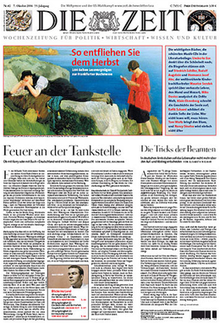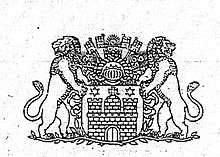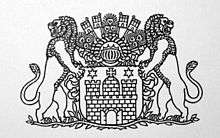Die Zeit
Die Zeit (German pronunciation: [diː ˈtsaɪt], literally "The Time") is a German national weekly newspaper published in Hamburg in Germany.[2][3] The newspaper is generally considered to be among the German newspapers of record and is known for its long and extensive articles.[4]
 The 7 October 2006 front page of Die Zeit | |
| Type | Weekly newspaper |
|---|---|
| Format | Broadsheet |
| Owner(s) | Zeit-Verlag Gerd Bucerius GmbH & Co. KG (Holtzbrinck family through DvH Medien GmbH 50%, Holtzbrinck Publishing Group 50%) |
| Editor | Giovanni di Lorenzo |
| Founded | 21 February 1946 |
| Political alignment | Centrist Liberal[1] |
| Headquarters | Hamburg |
| Circulation | 505.640 (Print, 2018) 47,000 (Digital, 2018) |
| Website | www |
History
The first edition of Die Zeit was first published in Hamburg on 21 February 1946.[5][6] The founding publishers were Gerd Bucerius, Lovis H. Lorenz, Richard Tüngel and Ewald Schmidt di Simoni. Another important founder was Marion Gräfin Dönhoff, who joined as an editor in 1946. She became publisher of Die Zeit from 1972 until her death in 2002, together from 1983 onwards with former German chancellor Helmut Schmidt, later joined by Josef Joffe and former German federal secretary of culture Michael Naumann.
The paper's publishing house, Zeitverlag Gerd Bucerius in Hamburg, is owned by the Georg von Holtzbrinck Publishing Group and Dieter von Holtzbrinck Media. The paper is published weekly on Thursdays.[7]
As of 2018, Die Zeit has additional offices in Brussels, Dresden, Frankfurt, Moscow, New York, Paris, Istanbul, Washington, D.C. and Vienna. In 2018, it re-opened an office in Beijing.[8]
Orientation
The paper is considered to be highbrow.[9] Its political direction is centrist and liberal,[6] or left-liberal,[10] but has oscillated a number of times between slightly left-leaning and slightly right-leaning.
Die Zeit often publishes dossiers, essays, third-party articles and excerpts of lectures of different authors emphasising their points of view on a single aspect or topic in one or in consecutive issues. It is known for its very large physical paper format (Nordisch) and its long and detailed articles.
Print edition
Sections and supplements
The Zeit is divided into different sections, some of which are:
- Politik (English: politics)
- Streit (English literally: fight)
- Dossier (English: dossier)
- Geschichte (English: history)
- Wirtschaft (English: economy)
- Wissen (English: Science)
- Feuilleton (English: features)
- Zeitmagazin
Appearance and printing


The masthead lettering in the weekly Die Zeit with its elegant font was designed by Carl Otto Czeschka in 1946. Czeschka was inspired by the British daily newspaper The Times which shows the British national coat of arms in between The and Times. This was not only for graphic reasons, it also represented the founder's self-conception which he published in an editorial called "Unsere Aufgabe" (English: "Our Mission") on February 21, 1946.
The very first version of Czeschka's design, which included the Hamburg crest, was used from the first edition (published on February 21, 1946) to the 12th edition (published on May 9, 1946). Other than the official coat of arms this crest featured peacock's feathers with little hearts on them. Additionally, the position of the lions' legs first resembled those of the old great coat of arms. The positions were changed in 1952. Regardless of this tiny difference, the crest was viewed as the great Hamburg coat of arms by the Hamburg Senate and was therefore considered a national emblem. Upon this, the crest was revised: An open gate was supposed to be incorporated to represent the cosmopolitanism of the hanseatic city. However, the Senate also declined this version that was printed in editions 13 to 18, as it was viewed a misuse of a national emblem for commercial purposes, which is still prohibited to this day. To avoid another prohibition, Zeit Magazin changed its masthead on June 27, 1946, into the Coat of arms of Bremen: The key and the golden crown of the city coat of arms, which was approved by Wilhelm Kaisen, the mayor of Bremen. This happened as a result of the mediation from Josef Müller-Marein who later became the editorial director of the Zeit. The design with the Bremer Schlüssel in its masthead was also designed by Carl Otto Czeschka and is used as the logo of the whole publishing group today. With the demand from Ernst Samhaber, the Hamburg artist Alfred Mahlau had created the whole first edition which had a five-column break. The edition was printed in the printing house Broscheck in Hamburg. At the same time, Czeschka had also drawn the headlines of the first edition for the different sections of the newspaper. The articles of the Zeit and, especially the leading articles on the first page, are traditionally longer and more detailed than the ones of a daily newspaper. However, in the past few years many articles have been noticeably shorter and include more pictures. Since the redesign by Mario Garcia in January 1998, the headlines have been printed in Tiemann-Antiqua. The running texts are printed in Garamond, a font that is very frequently used in books.
The Zeit did not join the discussion about the return of the traditional German orthography, which was led by Der Spiegel, Süddeutsche Zeitung and Bild. Starting in 1999, the newspaper used its in-house orthography which derived from the traditional orthography as well as from the different versions of the reformed orthography, which were edited by Dieter E. Zimmer. Since 2007, the Zeit refrained from using the in-house orthography and started following the recommendations of the Duden. The nordisch format, a trademark of the newspaper, has always been addressed in literature and cabaret—mostly in satirical form. According to Hanns Dieter Hüsche the Zeit is "so groß, wenn man die aufschlägt, muss der Nachbar gleich zum Zahnarzt" (English literally: "so big, if you open it, the neighbour must go to the dentist immediately"). In reality however, the format is not bigger than that of a dozen other German newspapers. The Zeit is printed by the printers Frankfurter Societäts-Druckerei GmbH in Mörfelden-Walldorf and Axel Springer SE in Ahrensburg. The Deutscher Pressevertrieb, based in Hamburg, is in charge of the distribution of the newspapers.
Zeitmagazin
The Zeitmagazin was first published as a supplement in 1970 and later discontinued in 1999. The Zeit then introduced the section Leben (English: Lifestyle). Since May 24 2007, the Zeit reintroduced the Zeitmagazin. For the supplement's 40th birthday, the Zeit published a 100-page anniversary issue, including 40 different covers - one for each year.
Zeit online
Zeit Online is run by Zeit Online GmbH, a fully owned subsidiary of the publishing company Zeitverlag. The independent editorial office consists of around 70 editors, graphic designers and technicians. Upon February 1, 2009, Zeit Online, Tagesspiegel Online and zoomer.de were merged into Zeit Digital with one joint editorial office in Berlin. Only some editors as well as the technology and the marketing departments remained in Hamburg. Zoomer.de was discontinued in February 2009, and the editorial office of Tagesspiegel Online was handed back to Tagesspiegel in September 2009. In 2017, Die Zeit was among the most quoted sources in German Wikipedia. At present, it is one of the 100 most visited websites in Germany.
Sections:
The content is categorized into four section groups that each consist of one or more sections, as follows:
- Politics, Economy and Society
- Culture and Discovery
- Knowledge & Digital
- Sports
Since April 2014, Zeit Online also has been publishing a local section for Hamburg.
In a survey of German literature blogs, the literature section of Zeit Online was rated as the best portal, better than the literature section of Spiegel, Süddeutsche Zeitung and Frankfurter Allgemeine amongst others.
On November, 2nd 2012, Zeit online launched a Content API that developers can use.
Website traffic:
Up to 2017, the Zeit experienced a significant increase in clicks on their website. In March 2017, Z+ was launched and so was a payment model for the new product. Since then, some of the content has only been available after payment.
In January 2019, the website was visited 75,1 million times. On average, 2,34 pages were opened per visit.
Recent History:
Gero von Randow, a former Zeit editor, was the editor-in-chief until February 2008. The journalist Wolfgang Blau took over his position in March of that year. Blau joined The Guardian in April 2013. Since March 15th, 2013, Jochen Wegner has been in charge. He had been the editor-in-chief at Focus Online from 2006 to 2010.
Being part of the same publishing group, Zeit and Berliner Tagesspiegel decided to cooperate in September 2006. Since then, they have been exchanging and sharing some of their online content. Zeit has similar relationships with other German online news portals such as the Handelsblatt and Golem.de.
Cooperations
In June 2008, Zeit Online started a cooperation with ZDF and broadcast their news in a display format called 100 Sekunden (English: 100 seconds). Starting 2018, the online presence of brand eins and Zeit Online were merged and are now marketed together.
Zuender
Between 2005 and 2009, Zeit Online introduced Zuender (English: igniter) which was an online platform for young adults in Germany between the ages of 16 and 25.
Zeit Campus Online
Zeit Campus Online started in 2006 as an online version of the printed magazine Zeit Campus.
Störungsmelder
In 2007, Zeit Online started a cooperation with the music magazine Intro, the union Gesicht Zeigen! (English: show face) and the agency WE DO as well as the moderators Markus Kavka, Ole Tillmann and Klaas Heufer-Umlauf. The project is called Störungsmelder (English: trouble report) and is directed against right-wing extremism.
Netz gegen Nazis
On May 5, 2008, Zeit Online started a project in cooperation with partners such as the German Football Association, the German Fire Department Association, the VZ-networks, the ZDF and the German Olympic Sports Confederation to start the online platform Netz gegen Nazis (English: web against Nazis). The web portal was subject to criticism from the journalists. This was based on the platform not providing new information and only arguing superficially. On January 1 2009, die Zeit withdrew their contribution to the project and handed over administration to the Amadeu Antonio Foundation. The project has since been renamed to Belltower.News.
ze.tt
On July 27, 2015, the publishing house started a new online format called ze.tt, aimed at young readers who spend a large amount of time on social-media.
Zeitmagazin International
Zeit has published Zeitmagazin International (sometimes also referred to as The Berlin State of Mind) twice a year since 2013. It contains articles from the weekly magazine which accompanies the newspaper, translated into English.
English-language online presence
A selection of stories are published in English at www.zeit.de/english/index.[14]
Controversy
Big Brother Award
In June 2019, the Zeit Online was awarded with the Big Brother Award in the category consumer protection.[15]
Related Articles
References
- Michael Kohler (May 2012). "Die Zeit" – Erfolg mit Qualität. Retrieved 5 May 2018.
- "Marion Gräfin Dönhoff – Obituaries, News". The Independent. 12 March 2002. Retrieved 30 October 2010.
- "The yin and yang of human rights in China". The Japan Times Online. 5 September 2010.
- https://www.nytimes.com/2011/03/14/business/global/14bild.html
- Catherine C. Fraser; Dierk O. Hoffmann (1 January 2006). Pop Culture Germany!: Media, Arts, and Lifestyle. ABC-CLIO. p. 200. ISBN 978-1-85109-733-3. Retrieved 1 November 2014.
- Sigurd Hess (2009). "German Intelligence Organizations and the Media". Journal of Intelligence History. 9 (1–2): 75–87. doi:10.1080/16161262.2009.10555166.
- Milton Hollstein (March 1982). "Springer-Germany's Most Remorselessly Criticized Publishing Giant". Journalism & Mass Communication Quarterly. 59 (1). Retrieved 7 April 2015.
- Andrea Shalal (May 7, 2018), German official voices concern over limits on foreign press in China Reuters
- "Divided on unification". The Economist. 4 October 2010. Retrieved 3 February 2015.
- Hans-Ulrich Wehler (2008). Deutsche Gesellschaftsgeschichte Bd. 5: Bundesrepublik und DDR 1949-1990. C.H.Beck. p. 401.
- Peter Humphreys (1996). Mass Media and Media Policy in Western Europe. Manchester University Press. p. 82. Retrieved 29 October 2014.
- "The Die Zeit Universe" (PDF). ZEITmagazin. 1 January 2013. Archived from the original (PDF) on 12 June 2013. Retrieved 5 October 2013.
- Eric Pfanner (29 April 2013). "As One German Weekly Falters, Another Celebrates Big Gains". The New York Times. Serraval. Retrieved 1 November 2014.
- "Zeit Online Homepage". Zeit Online. Retrieved 6 February 2020.
- "ZEIT ONLINE erhält den Negativpreis „Big Brother Award"". Die Zeit (in German). 8 June 2019. Archived from the original on 20 July 2019. Retrieved 20 April 2020.